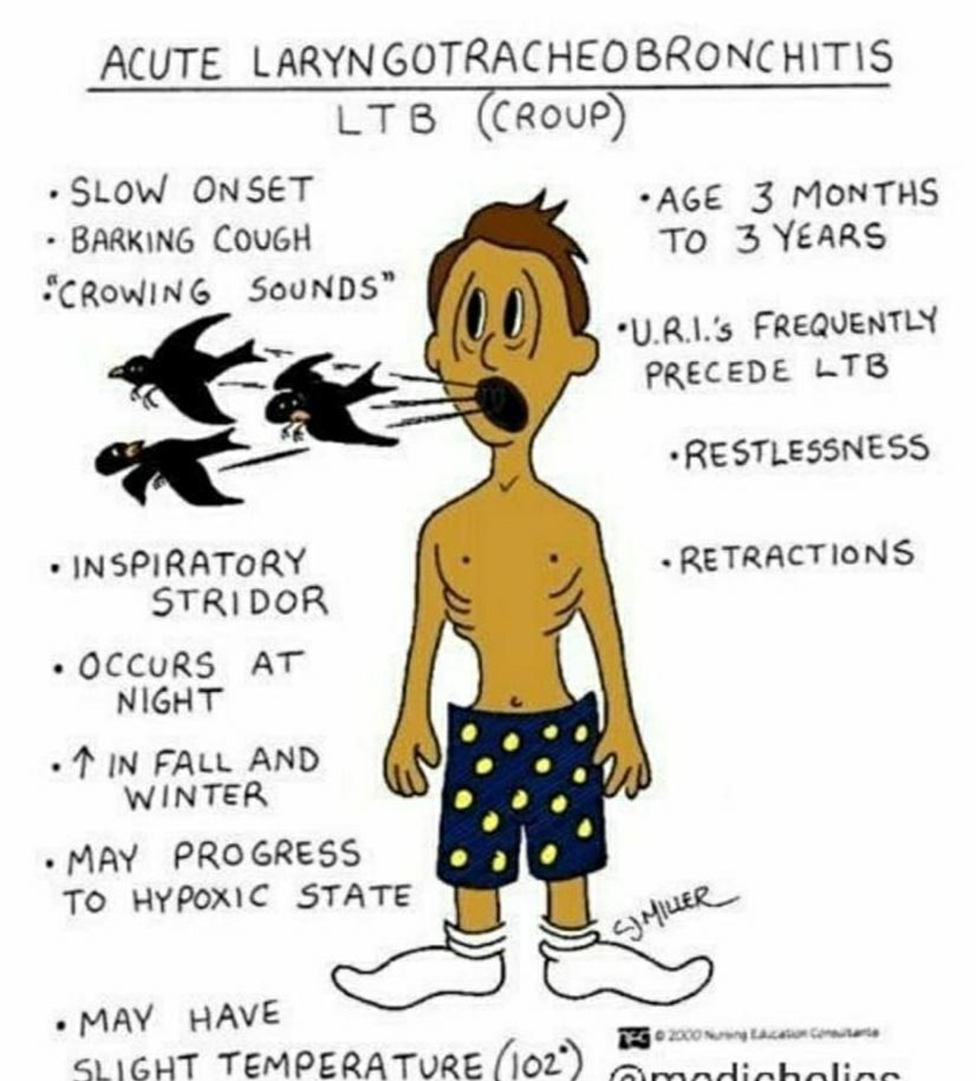The parent of a hospitalized 2-year-old child with viral laryngotracheobronchitis (croup) asks the nurse why the pediatrician did not prescribe antibiotics. Which response would the nurse make?
The child is too young to receive antibiotics
"Antibiotics are not indicated unless a bacterial infection is present.
The child may be allergic to antibiotics.
The child still has the maternal antibodies from birth and does not need antibiotics
The Correct Answer is B
A. The child is too young to receive antibiotics: This statement doesn't address the actual reason for not prescribing antibiotics for croup, which is primarily due to its viral nature.
B. "Antibiotics are not indicated unless a bacterial infection is present."
Explanation:
Viral laryngotracheobronchitis, commonly known as croup, is typically caused by a viral infection, most commonly by the parainfluenza virus. Antibiotics are not effective against viruses. Therefore, unless a bacterial infection is also present, prescribing antibiotics is not necessary or beneficial in treating croup.
C. The child may be allergic to antibiotics: While antibiotic allergies are a consideration, it doesn't explain why antibiotics are not prescribed for viral illnesses like croup.
D. The child still has the maternal antibodies from birth and does not need antibiotics: Maternal antibodies can offer some protection against infections, but the primary reason for not using antibiotics in viral infections like croup is because antibiotics are ineffective against viruses.

Nursing Test Bank
Naxlex Comprehensive Predictor Exams
Related Questions
Correct Answer is C
Explanation
A. That lethargy and vomiting are normal with mumps:
Incorrect: Lethargy and vomiting are not typical symptoms of mumps. These symptoms could indicate a separate issue that requires medical attention.
B. To continue to monitor the child:
Incorrect: Given the reported symptoms of lethargy and vomiting, a passive approach of continuing to monitor may delay necessary medical intervention. The child should be assessed promptly.
C. To bring the child to the clinic to be seen by the pediatrician:
Correct Answer: Lethargy and vomiting are not typical symptoms of uncomplicated mumps. These symptoms could be indicative of other issues, and it's important for the pediatrician to evaluate the child to determine the cause and provide appropriate care.
D. That there is nothing to be concerned about as long as there is no fever:
Incorrect: While fever is a common symptom of mumps, the absence of fever does not negate the need for further evaluation when there are concerning symptoms like lethargy and vomiting. The child should be seen by a healthcare provider to determine the cause of these symptoms.
Correct Answer is ["A","B","E"]
Explanation
A."The manifestations are lessened by taking the prednisone every other day instead of daily."
Explanation: Cushingoid characteristics can be related to prolonged corticosteroid use. Adjusting the dosing schedule, such as administering prednisone every other day instead of daily, may help minimize these manifestations.
B."You need to be sure to talk to the doctor about the Cushingoid characteristics."
Explanation: Open communication with the healthcare provider is crucial. Discussing the concerns about Cushingoid characteristics with the doctor allows for appropriate evaluation and potential adjustments to the treatment plan.
C."Which manifestations of this condition do you find most troublesome?"
Explanation: This question opens the discussion to identify specific concerns and allows the nurse to address them individually.
D."I am sure it will be all right; they hardly look unusual."
Explanation: This statement may downplay the parents' concerns. It's essential to acknowledge their worries and provide accurate information about the potential impact of corticosteroids and the plan for managing Cushingoid characteristics.
E."The Cushingoid appearance will gradually disappear once the corticosteroids are tapered and discontinued."
Explanation: Cushingoid characteristics are associated with the side effects of corticosteroid use. The nurse should provide reassurance that, in many cases, these characteristics can gradually improve once the corticosteroid dose is tapered and eventually discontinued.
Whether you are a student looking to ace your exams or a practicing nurse seeking to enhance your expertise , our nursing education contents will empower you with the confidence and competence to make a difference in the lives of patients and become a respected leader in the healthcare field.
Visit Naxlex, invest in your future and unlock endless possibilities with our unparalleled nursing education contents today
Report Wrong Answer on the Current Question
Do you disagree with the answer? If yes, what is your expected answer? Explain.
Kindly be descriptive with the issue you are facing.
